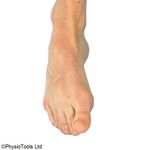Achilles Tendinopathy - Musculoskeletal Physiotherapy Information for patients - NHS TIMS
←
→
Page content transcription
If your browser does not render page correctly, please read the page content below
Tyneside Integrated Musculoskeletal Service
Booking Office: 0191 4452643
(lines open 08:00 to 20:00)
Musculoskeletal Physiotherapy
Information for patients
Achilles Tendinopathy
Introduction
The purpose of this leaflet is to provide you with some general advice
about Achilles Tendinopathy, how to manage your pain and some simple
exercises.
What is Achilles Tendinopathy?
Achilles tendinopathy (tendinosis) is a common condition that affects the
tendon that connects your calf muscles to the heel bone (calcaneus).The
Achilles tendon is the strongest in the body, allowing you to push up the
weight of your body onto your tiptoes. It therefore takes a lot of stress as
you walk. Sometimes due to increased or abnormal stress to the tendon
(i.e. a sudden increase of activity such as running, jumping or standing for
longer periods) the tendon can become painful and swelling and stiffness
can occur. Certain activities (such as running, jumping) will need to be
modified to allow the tendon to settle down and heal. For most people the
symptoms of Achilles tendinopathy usually clear within 3-6 months of
starting treatment.
What are the symptoms Achilles
Tendinopathy?
Achilles tendinopathy pain is usually felt above
the heel and into the lower portion of your calf.
It tends to feel very stiff in the morning which
improves after a few minutes walking. The
tendon itself can sometimes become swollen
and tender to touch. The level of pain itself can
vary from soreness after exercising to severe
pain that limits exercise entirely.
PhysioTools 1/5How is this condition diagnosed? Achilles tendinopathy is usually diagnosed by a doctor or physiotherapist. Scans/x-rays are not usually needed unless there is a suggestion of a complete rupture of the tendon. In this case, an ultrasound scan can be used. What causes Achilles Tendinopathy? The cause of Achilles tendinopathy is not yet completely understood but we know that tendinopathy occurs when a tendon is unable to adapt to the strain placed upon it. As such there are certain factors that are thought to increase your risk: - Age: The condition is more commonly found after the age of 30. - Gender: It is more common in men. - Weight: Being overweight leaves you more at risk of an Achilles tendinopathy. - Long periods on your feet i.e. walking or running results in prolonged loading of the tendon. - Tightness and/or weakness in the calf muscles affects ankle flexibility and the ability to tolerate prolonged activity. - Diabetes: People with Diabetes can be at an increased risk of developing Achilles tendinopathy. - The knee not being aligned over the foot during movement due to weak leg and pelvic muscles can result in increased stresses on the Achilles tendon resulting in a tendinopathy over time. - Stiff joints in the foot. - Footwear with poor cushioning/support for the foot. - Exercise where you have poor balance and control of your lower limb movement can also increase your risk of developing Achilles tendinopathy. Common exercise related causes: - Running further than you are used to. - Running at a higher intensity than you are used to. - Old or poor quality footwear. How can I treat my Achilles tendinopathy? Thankfully, Achilles tendinopathy can usually be treated through activity modification and exercise. Relative rest/modification of activity: - Although keeping active is important, certain activities such as running and jumping are likely to aggravate symptoms. It is therefore advised that you reduce these activities to a level that doesn’t cause symptoms, or change your activity (e.g. to swimming or cycling.) PhysioTools 2/5
Ice therapy - Ice can help in reducing pain and possible swelling around the tendon – wrapping an ice pack in a towel and placing it against the Achilles (for no more than 15-20 minutes) at regular intervals throughout the day (i.e. four times a day if possible) and after exercise. Footwear - Shoes should be supportive but not compressive around the foot, with well cushioned soles. – avoid high heels, loose fitting shoes or sandals. Your doctor or physiotherapist may refer you to podiatry for shoe inserts. Physiotherapy and exercise A physiotherapist can provide you with exercises to improve strength and flexibility in your ankle. Evidence shows that exercises that improves strength when the muscle lengthens / and with the muscle shortens can gradually improve the tendons ability to cope with load. The exercises are done in a controlled way and should help to gradually reduce pain and swelling. This programme can take up to approximately six months to significantly improve your symptoms, however, this is only a guide as symptoms can improve a lot quicker than that. Unfortunately there are no ‘quick fixes’ for this condition. Morning stiffness is usually the first symptom to improve however pain and discomfort on touching/squeezing the tendon can take longer to settle. Note that during the concentric (muscle shortening) / eccentric (muscle lengthening) exercise programme you may experience an increase in pain. As long as this pain is at a low level (3-4 out of 10 on your pain scale) and as long as the pain settles within 20-30 mins, this is acceptable. Your pain will reduce as you continue with your rehabilitation. In the initial stages try PhysioTools 3/5
and keep your ankle moving by:
Comfortably pointing your foot away from you and
back up again towards your face till you feel a stretch
in the back of the calf. Hold for 20 seconds or as able.
Repeat this exercise 5-10 times 2-3 times a day or as
able.
Turn your ankle fully inwards and outwards or as able
till you feel a stretch on either side of the ankle. Hold
the stretch for 5-10 seconds. Repeat this exercise 5-
10 times, 2-3 times a day (or as able).
Sitting or lying on the floor or sofa with your knee
straight and your foot either flat against a wall or sofa.
Push the ball of the foot against the wall or sofa. Hold
the contraction for 5-10secs (or as able) x 5-10 times,
2-3 times a day.
If this regime is too much do the exercises at least once as a minimum.
The physiotherapist may also need to address any lower limb alignment
problems that may be contributing to your foot pain.
You may feel some mild discomfort during these exercises but if
you feel an increase in pain then seek advice from the
physiotherapist before continuing.
For further information
Please ring our Booking Office on 0191
4452643 or visit our website at:
www.tims.nhs.uk which provides online
guidance and support on managing your
musculoskeletal (MSK) condition effectively.
PhysioTools 4/5The NHS website also provides trusted online
information and guidance on all aspects of
health and healthcare to help you manage your
condition and/or inform your choices about
your health: www.nhs.uk
Feedback
We also welcome feedback from patients
about their experiences with our service and
this can be done through our patient advice
and liaison (PALS) team on 0800 032 0202 or
northoftynepals@nhct.nhs.uk
Review date: October 2020
Tyneside
Integrated
Musculoskeletal
Service
TIMS is a partnership between Newcastle upon Tyne
Hospitals NHS Foundation Trust and Gateshead
Health NHS Foundation Trust
PhysioTools 5/5You can also read
























































